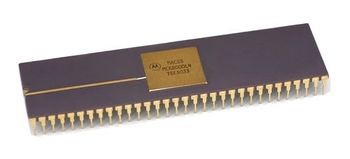Motorola 68000: Difference between revisions
No edit summary |
No edit summary |
||
| (10 intermediate revisions by the same user not shown) | |||
| Line 1: | Line 1: | ||
[[File:MC68000.jpg|thumb|350px|right]] | [[File:MC68000.jpg|thumb|350px|right]] | ||
{{Monolithic IC | |||
|Manufacturer=Motorola | |||
|Model=MC68000 | |||
|Part_nos=156-1445-00 | |||
|Description=16-bit microprocessor | |||
|Used_in=4041;AM700;DAS9200;Keithley 182;RTD710;SG5030;Prism 3002; | |||
|Designers= | |||
}} with internal 32-bit architecture and buses, introduced in 1979. | |||
It requires +5 V | It requires +5 V power only and came initially in 64-pin DIL packages. The external bus is asynchronous. | ||
The 68000 has non-multiplexed data (16 bit) and address (24 bit) buses. The '''68008''' was a version with an 8-bit external data bus, initially available in a 48-pin DIL package. The '''68010''' (1982) included minor improvements to support virtual memory and virtualization. | The 68000 has non-multiplexed data (16 bit) and address (24 bit) buses. The '''68008''' was a version with an 8-bit external data bus, initially available in a 48-pin DIL package. | ||
The '''68010''' (1982) included minor improvements to support virtual memory and virtualization. | |||
The data ALU is 16 bits wide. | The data ALU is 16 bits wide. | ||
Initial speed grades were 4, 6 and 8 MHz. Faster versions and CMOS implementations were available later, as were second-source versions. | Initial speed grades were 4, 6 and 8 MHz. Faster versions and CMOS implementations were available later, as were second-source versions. | ||
The original 4 MHz Motorola 68000 CPU was [[Media:Component_news_279.pdf|added to the Tek parts inventory in March 1980]] as P/N 156-1445-00, at a unit cost of $150 (~$560 in 2023 dollars). | |||
[[File:Motorola 68000.png|thumb|300px|right|DIL Pinout (click to enlarge)]] | [[File:Motorola 68000.png|thumb|300px|right|DIL Pinout (click to enlarge)]] | ||
==Links== | ==Links== | ||
| Line 14: | Line 26: | ||
==Used in== | ==Used in== | ||
* [[ | * [[AM700]] – MC68040 (U64, main CPU), MC68340 (U110, I/O processor) | ||
* [[ | * [[DAS9200]] – 68010 | ||
* | * [[SG5030]] – 68HC000 (PLCC68) | ||
* [[Prism 3002]] – 68010 | |||
{{Part usage}} | |||
==Supported by== | ==Supported by== | ||
Revision as of 06:22, 11 October 2024

The Motorola MC68000 (P/N 156-1445-00) is a 16-bit microprocessor monolithic integrated circuit with internal 32-bit architecture and buses, introduced in 1979.
It requires +5 V power only and came initially in 64-pin DIL packages. The external bus is asynchronous.
The 68000 has non-multiplexed data (16 bit) and address (24 bit) buses. The 68008 was a version with an 8-bit external data bus, initially available in a 48-pin DIL package.
The 68010 (1982) included minor improvements to support virtual memory and virtualization.
The data ALU is 16 bits wide.
Initial speed grades were 4, 6 and 8 MHz. Faster versions and CMOS implementations were available later, as were second-source versions.
The original 4 MHz Motorola 68000 CPU was added to the Tek parts inventory in March 1980 as P/N 156-1445-00, at a unit cost of $150 (~$560 in 2023 dollars).

Links
- Motorola 68000 @ Wikipedia
Used in
- AM700 – MC68040 (U64, main CPU), MC68340 (U110, I/O processor)
- DAS9200 – 68010
- SG5030 – 68HC000 (PLCC68)
- Prism 3002 – 68010
Some instruments using part Motorola 68000
| Instrument | Manufacturer | Class | Model | Description | Introduced |
|---|---|---|---|---|---|
| 4041 | Tektronix | Computer | 4041 | BASIC-programmable computer | 1982 |
| AM700 | Tektronix | Audio/Video | AM700 | Audio Measurement System | (?) |
| DAS9200 | Tektronix | Logic Analyzer | DAS9200 | Logic Analyzer | 1986 |
| Keithley 182 | Keithley | Multimeter | 182 | 6½-digit sensitive voltmeter | (?) |
| Prism 3002 | Tektronix | Logic Analyzer | PRISM 3002 | Logic Analyzer | 1992 |
| RTD710 | Sony/Tektronix | Oscilloscope | RTD710 | 100 MHz digitizer | 1988 |
| SG5030 | Tektronix | Plug-in | SG5030 | leveled sinewave generator | 1991 |
| THS720 | Tektronix | Oscilloscope | THS720 | 100 MHz 2-ch portable digital scope | (?) |